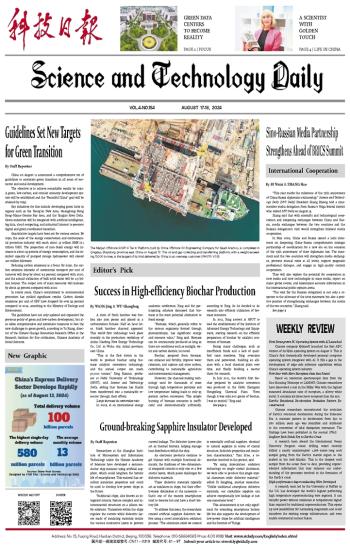
 Green Data Centers to Become Reality
Green Data Centers to Become Reality A Scientist with Golden Touch
A Scientist with Golden Touch Guidelines Set New Targets for Green Transition
Guidelines Set New Targets for Green Transition Sino-Russian Media Partnership Strengthens Ahead of BRICS Summit
Sino-Russian Media Partnership Strengthens Ahead of BRICS Summit PHOTO NEWS
PHOTO NEWS Success in High-efficiency Biochar Production
Success in High-efficiency Biochar Production WEEKLY REVIEW
WEEKLY REVIEW New Graphic
New Graphic Ground-breaking Sapphire Insulator Developed
Ground-breaking Sapphire Insulator Developed
China on August 11 announced a comprehensive set of guidelines to accelerate green transition in all areas of economic and social development.
The objective is to achieve remarkable results by 2030. A green, low-carbon, and circular economy development system will be established and the "Beautiful China" goal will be attained by 2035.
Key initiatives for this include developing green hubs in regions such as the Xiong'an New Area, Guangdong-Hong Kong-Macao Greater Bay Area, and the Yangtze River Delta. Green industries will be integrated with artificial intelligence, big data, cloud computing, and industrial Internet to promote digital and green coordinated transition.
Quantitative targets have been set for various sectors. By 2030, the scale of the energy conservation and environmental protection industry will reach about 15 trillion RMB (2.1 trillion USD). The proportion of non-fossil energy will increase to about 25 percent of energy consumption, and the installed capacity of pumped storage hydropower will exceed 120 million kilowatts.
Reducing carbon emissions is a focus. By 2030, the carbon emission intensity of commercial transport per unit of turnover will drop by about 9.5 percent compared with 2020, and the annual utilization of bulk solid waste will be 4.5 billion tonnes. The output rate of main resources will increase by about 45 percent compared with 2020.
In recent years, China's commitment to environmental protection has yielded significant results. Carbon dioxide emissions per unit of GDP have dropped by over 35 percent compared to 2012, according to the Ministry of Ecology and Environment.
The guidelines have not only updated and expanded the previous policy of green and low-carbon development, but also taken comprehensive and systematic measures to face the new challenges to green growth, according to Yu Xiang, director of the Climate Change Economics Research Office at the Research Institute for Eco-civilization, Chinese Academy of Social Sciences.

 Next
Next



